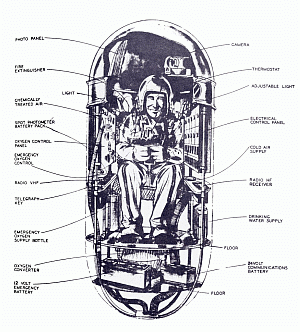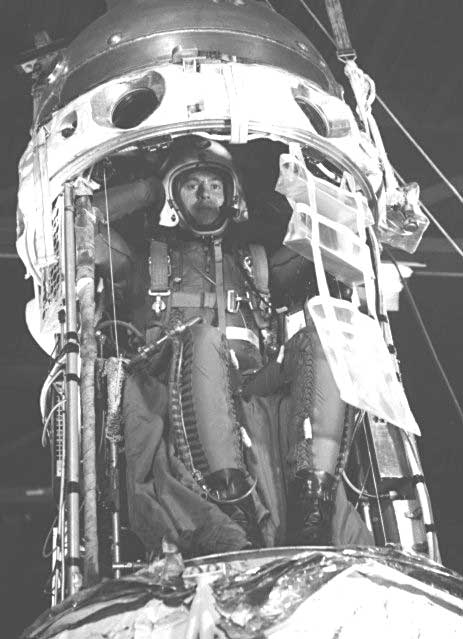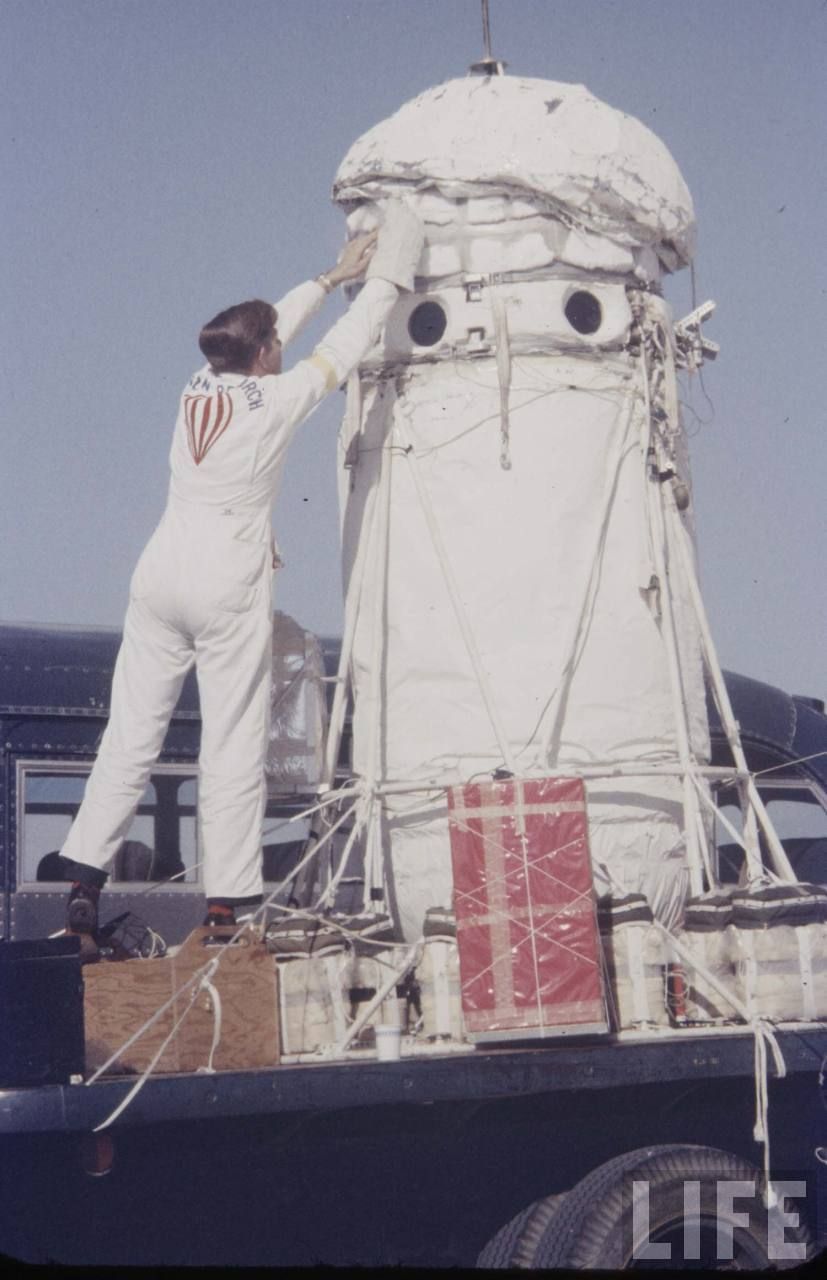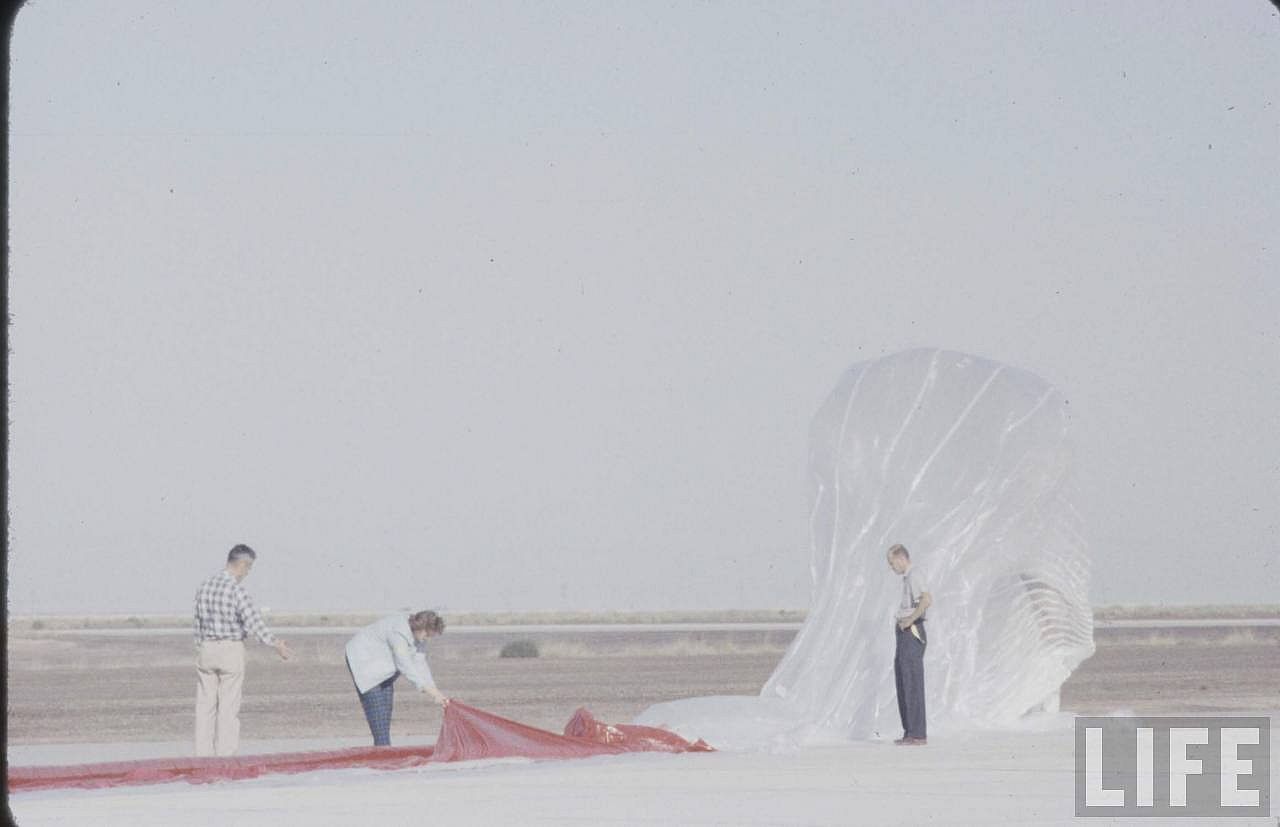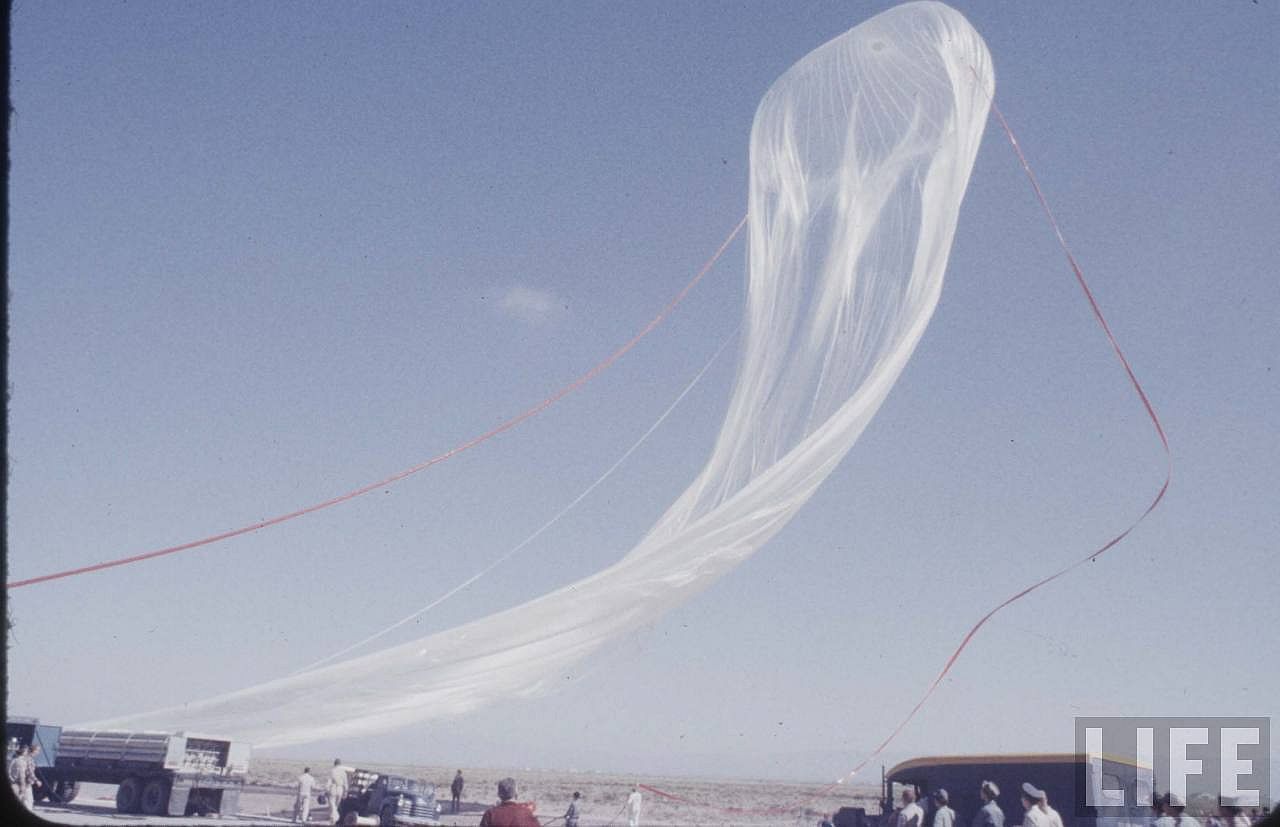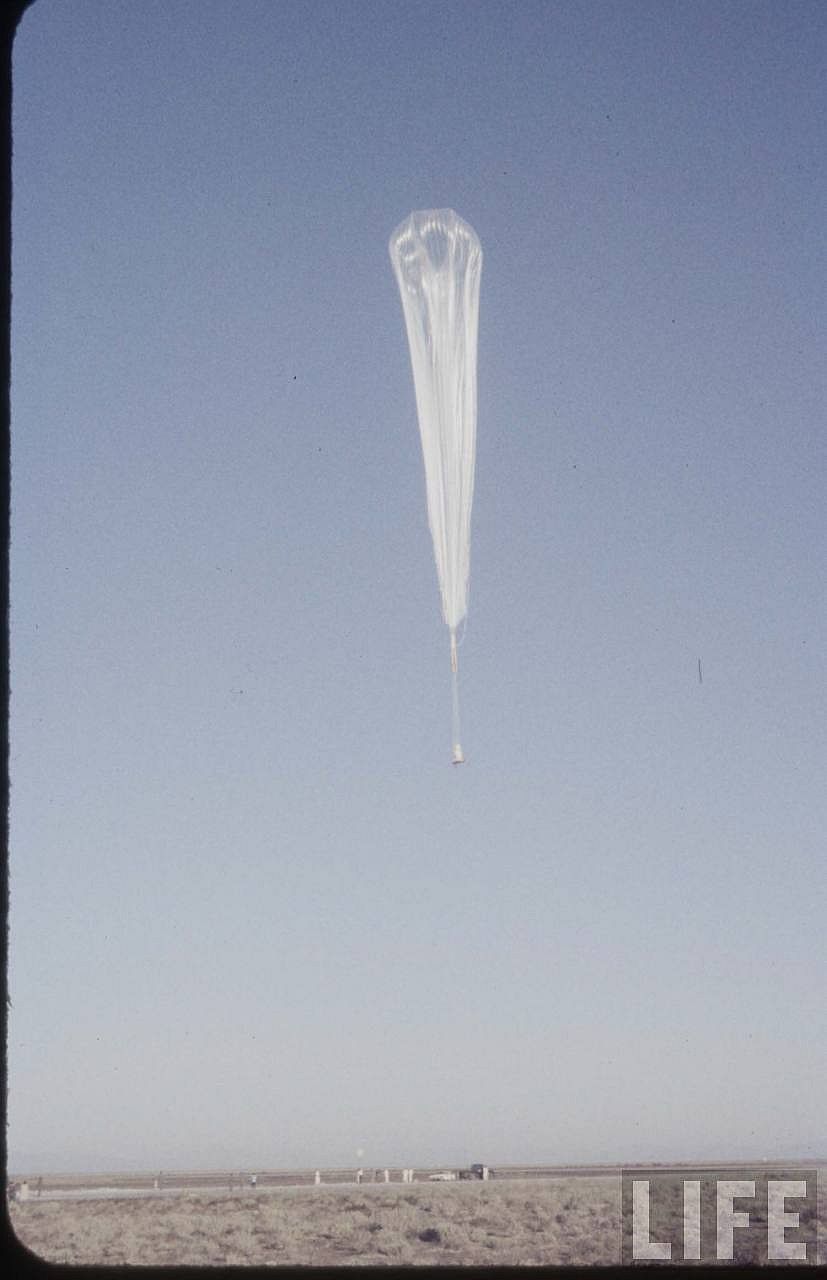Purpose of the flight and payload description
Project Manhigh was a United States Air Force balloon flight program designed to investigate the human factors of space flight by taking men into the stratosphere. Since space is considered a hostile environment, in the middle 50's the Air Force needed to know how humans could survive there and sought to discover more of the design principles for space capsules and how to study men and their reactions when in space. The collection of such data would permit intelligent planning of future space flight experiments.
Dr. John P. Stapp, who was then chief of the Aeromedical Field Laboratory, Air Force Missile Development Center, had approved the project at the local level and forwarded it through channels to obtain the necessary headquarters approval. Dr. David G. Simons of the Aeromedical Field Laboratory, was appointed the Air Force Project Officer.
Contracts for the construction of the balloon and capsule, the balloon training of the pilots and the launch support were let to Winzen Research Inc., Minneapolis, Minnesota. Planning was jointly conducted by Holloman AFB and Winzen personnel.
As the Air Force has always considered safety to be paramount, before men were allowed to ascend in the capsule, there were six unmanned flights to test all portions of the system. Also the pilot went trought a hard preparation including a parachute jump, a 24 hour claustrophobia test in the capsule, and numerous ground tests using the capsule climate control system, including a test in the high-altitude, low-temperature test chamber at Wright Air Development Center (now Wright-Patterson AFB).
The capsule used in the project was basically the same with some improvements from flight to flight (click over the top image to see a detail of it). It was an aluminum-alloy, hermetically-sealed unit 8 feet high and 3 feet in diameter, with hemispherically-shaped ends. The capsule was supported in an upright position by a tubular aluminum structure with various expendable equipment attached. This structure was especially designed to serve as a shock-absorbing system during landing operations. The capsule shell was constructed of three separate sections hermetically sealed together by two circumferential clamps. The turret casting, with six portholes, was the load-carrying member for almost all the internal structure and equipment.
The capsule was attached to an open, 40.4 foot extended skirt parachute with six suspension fittings positioned circumferentially around the turret casing. The parachute was, in turn, attached to the balloon by a stabilizing suspension system to retard any capsule oscillations during the flight.
The internal pressure of the capsule was the equivalent to that of 26,000 feet, line oxygen for the pilot's breathing and for cabin pressurization was provided by a 5-liter liquid oxygen converter and a 205-cubic-inch, high-pressure bottle. An emergency 90-cubic-inch bailout supply was installed in the personal parachute harness worn by the pilot. The sealed atmosphere in the capsule was chemically treated to remove carbon dioxide and moisture, and an external water evaporation cooling system was used to maintain the capsule temperature at a comfortable level.
Electrical and communications equipment was primarily installed inside the capsule. The main exception was the lead acid battery power supply. The batteries, mounted on the lower undercarriage ring and equipped with individual parachutes, were used as ballast when expended. In addition to the battery ballast, fine control was made possible by dropping steel shot through a metering valve mounted below the ballast container. A total of 246 pounds of ballast was carried on this flight.
The communications equipment for Manhigh I included a Very High Frequency (VHF) transceiver with an integral Visual Omni Receiver (VOR) receiver and a High Frequency (HF) receiver for voice communications. In addition, there was a telemetering transmitter for Continuous Wave (CW) transmission in the event of failure of the voice communications system.
Sequence cameras provided continuous recording of the flight progress, including photographs of the instrument panel and of the earth during the flight.
The pilot was in relative control of the balloon through an electrically-driven, 14 inch diameter, fail-safe gas valve located at the balloon apex wich could be activated from the capsule. It was used to release helium gas in order to decrease the rate of ascent, and initiate or increase the rate of descent.
Manhigh III's flight system was very similar in size and shape to that of Manhigh I and II, with many refinements and additional equipment incorporated. One of the changes included enlarging the capsule to 9 feet in length while the diameter remained at 3 feet.
One unit that reflected considerable difference was the air regenerator. The previous flights utilized this unit outboard, ducting the air from the capsule out and back. The Manhigh III unit was inboard, with a blower picking up the capsule atmosphere directly. The chemicals previously used were discarded in favor of potassium hydroxide (KOH), because it offered greater activity in absorbing carbon dioxide and had the ability to absorb water too. The new air regenerator system used 16 pounds of KOH in stick form inserted into one-half inch diameter steel spring retainers. Because KOH is so caustic, valves were installed in the outlet and inlet which could be manually operated by the pilot to seal off the unit during landing.
The unit was also designed so no liquid would reach the ports if the regenerator were laying on any side, a likely condition if the capsule landed and fell over.
Video footage of the mission
Details of the balloon flight
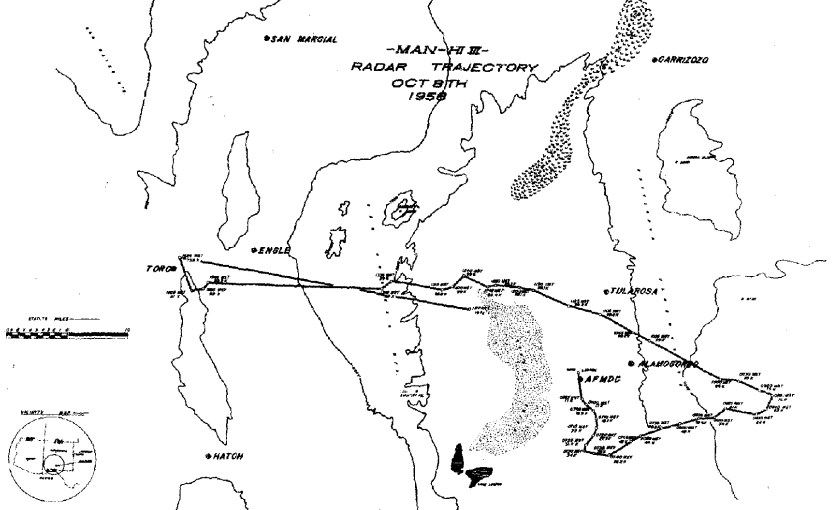
Balloon launched on: 10/8/1958 at 6:25 local
Launch site: Holloman Air Force Base, Alamogordo, New Mexico, US
Balloon launched by: Balloon Branch, Holloman Air Force Base (HAFB)
Balloon manufacturer/size/composition: Zero Pressure Balloon Winzen - 3.000.000 cuft
Balloon serial number: 200-150-V-17
Flight identification number: WRI 803A
End of flight (L for landing time, W for last contact, otherwise termination time): 10/8/1958 at 18:42 local
Balloon flight duration (F: time at float only, otherwise total flight time in d:days / h:hours or m:minutes - ): ~ 12 h
Landing site: Near Holloman AFB, New Mexico, US, USA
Campaign: MANHIGH
Gondola weight: 747 kgs
This was the third and last flight of the Manhigh project. The pilot choosen for the flight was Clifton M. McClure who was born in 1932 in Anderson, South Carolina, and received a bachelor of science degree in materials engineering and a master of science degree in ceramic engineering from Clemson University. Upon graduation in 1954, he was commissioned and joined the US Air Force.
Initially scheduled for launch in Minnesota in August, the weather not cooperated and the flight was moved to Holloman Air Force Base (HAFB) for launch thus losing the possibility to get cosmic radiation data. After the decision to move to HAFB was reached, an Air Force C-47 left Minnesota on 3 October 1958 with all necessary equipment, including the only two balloons manufactured to manned flight specifications.
A command decision was made on the afternoon of 6 October to prepare for flight unless the wind situation deteriorated. Balloon inflation begin but, then, 10 minutes before inflation could have been completed and the flight launched, a gust of wind caught the big balloon and destroyed it. The launch was rescheduled for the following morning using the remaining balloon.
On 8 October, the mission proceeded normally up to the point where a person on the ground asked for a reading of item seven from the checklist. As the pilot, Lieutenant Clifton Mc Clure turned to comply with this request, the chest pack parachute, whether through improper packing or the accidental pulling of the ripcord, popped open and the parachute dropped into his lap. The parachute, included for pilot escape if the emergency capsule parachute malfunctioned, was one of a kind. It was specially rigged for use in this capsule and there was no replacement at the HAFB. Although he was not trained as a parachute packer, Mcclure had, several months prior, carefully observed the packing procedure. Risking a mission abort, McClure exerted superhuman effort to repack the parachute twice. The task was complete merely 20 minutes prior to launch.
On previous Manhigh missions, the dome had been repacked with dry ice within an hour of launch. Apparently, Mcclure was reporting a cooler, more comfortable capsule temperature during the preflight than he had reported the day prior. Therefore, contractor engineers decided not to repack the capsule dome with dry ice, but to send the balloon aloft without additional cooling.
This action will be the key of the late troubles with the capsule's temperature.
At 6:51 on 8 October 1958 the Manhigh III flight leaved the ground and the mission started.
The initial ascent rate required Mcclure to valve off the excess flee lift during the first half hour. Instrumentation and voice communications seemed to be working well. Telemetry exhibited a little interference, but all channels appeared to be functioning properly. However, the panel temperatures as read by Mcclure were inordinately high at 118 degrees F. It was soon discovered that because of an error in placement of the sensing element, this reading was wrong. Ceiling altitude of almost 100,000 feet was reached at about 10. At noon there was a radio interview with a newsman, which Mcclure reported was very exhausting. A test scheduled for 12:45, but not completed, involved Mcclure attempting to track a missile from launch to impact with the target at 80,000 feet. This was to be the first downward viev of a missile firing. Unfortunately, the
missile launch was cancelled at 13:00. About this time, the Command Post personnel discovered that Mcclure's voice revealed signs of deteriorated performance. He reported that he felt warm, and his pulse rate and temperature had increased. Capsule temperature was still within normal limits, causing concern. It was discovered that Mcclure had not consumed any liquid for the past eleven hours so he was directed to consume water, discovering that the tube of his drinking water supply was not functioning properly, and being able to get only a few drops of water at a time.
After working on the system for about 10 minutes, he discovered a method to correct the problem and began his liquid intake.
Capsule temperature at head level had climbed to 96 degrees and McClure's intemal temperature was also still climbing.
At about 14:00, the Command Post personnel decided to end the mission and ordered Mcclure to valve off gas and descend. One hour later it was determined the balloon had descended only a few thousand feet and a consistent and reliable descent rate had not been established.
McClure's internal temperature had now reached 104.1 degrees. By 16:00, the balloon had established a descent rate of approximately 500 feet per minute and was passing through the 87,000 feet mark.
After another hour, Mcclure's internal temperature had gone up another degree, but the capsule temperature had increased only one degree. The Command Post expressed concem that Mcclure would become unconscious. Had that occurred, the Command Post could have initiated separation and deployment of the parachute, but that would have resulted in a hard landing with possible injury to Mcclure.
Communications with Mcclure were permanently interrupted when he dropped his spot photometer on the floor. The instrument jammed the foot switch of the capsule transmitter so he could receive but not transmit.
The Commnand Post finally determined that Mcclure was still conscious when the flashing marker beacon on the capsule illuminated while the balloon had descended to 25,000 feet.
At 18:42 in the dark, the capsule landed within a few miles of the original launch site. The rescue helicopter landed close to the capsule in time to see Mcclure get out on his own legs.
After the flight, it was determined that McClure's final internal temperature reading was 108.5 degrees. An hour later, he was put in the base hospital and after intravenous fluids and a night's rest, Mcclure recovered the shape. After the flight in 1960 he was awarded with the Distinguished Flying Cross.
Nevertheless after this third flight of the MANHIGH project, Winzen performed several factibility studies aiming to made a fourth mission using a bigger capsule and a longer duration that project never passed the study phase.
External references
- Touching Space: The history of the project MANHIGH a Book wich offers the most comprehensive history of the project by Gregory Kennedy
- 50th anniversary of a forgotten space mission: Project Manhigh at The Space Review Magazine
- Clifton McClure - Space Hero and Personal Friend Glen May's web site
- Clifton McClure Bio International Space Hall of Fame
- Man High III, USAF Manned Balloon Flight Into the Stratosphere Technical Report, Air Force Missile Development Center, 1961
- Manhigh III on You Tube
- Manhigh III. USAF Manned Balloon Flight Into The Stratosphere Technical Report AFMDC-TR-60-16. 1961
- Manhigh Project Capsule on exhibition National Museum of the Air Force
- Observations on nickel-bearing cosmic dust collected in the stratosphere GRD Research Notes Nº 9, March 1959
- Photometry during Manhigh III balloon flight Technical report - Visibility Laboratory of the University of California, La Jolla Campus, 1959
- Radioactive aggregates in the stratosphere GRD Research Notes Nº 10, March 1959
- Space Probing Balloon In Early Descent Daytona Beach Morning Journal - Oct 8, 1958
882If you consider this website interesting or useful, you can help me to keep it up and running with a small donation to cover the operational costs. Just the equivalent of the price of a cup of coffee helps a lot.

